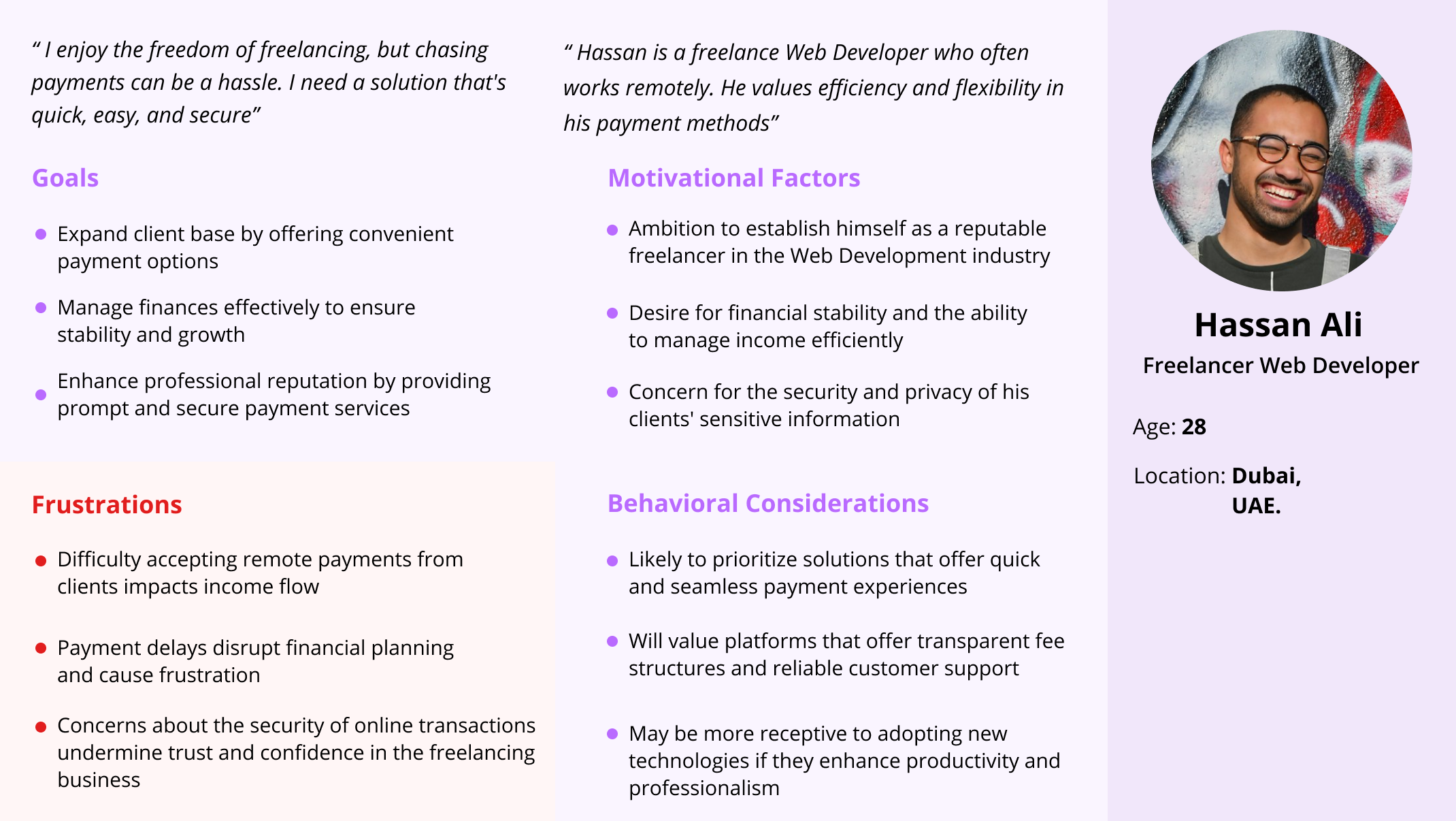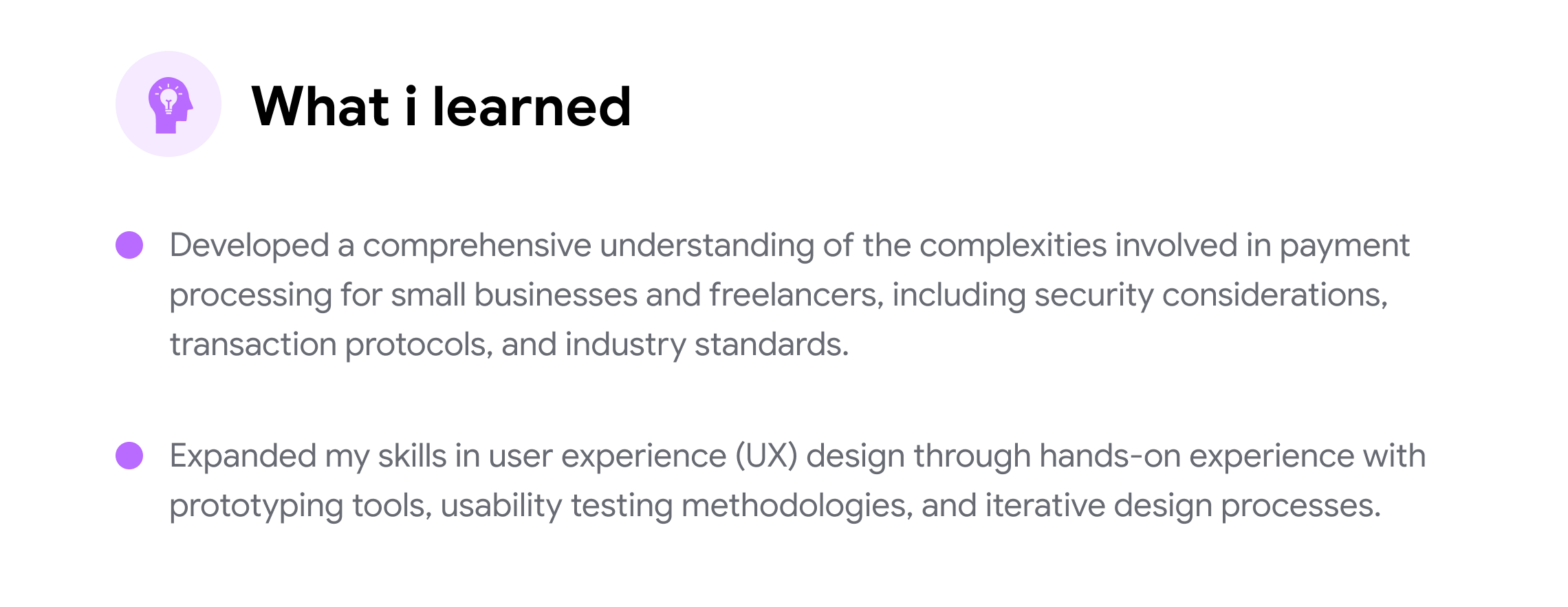Overview
The SwiftPay mobile application offers a contactless payment solution designed to help smaller businesses and freelancers collect money faster and easier. Our main goal is to streamline the payment process, allowing users to make transactions swiftly and securely. With SwiftPay, businesses can accept payments seamlessly, eliminating the need for cash or physical cards. We're committed to providing users with a smooth and hassle-free experience, ensuring efficient payment processing every time.
Roles & Responsibilities
In my role as a UX designer at SwiftPay, I led the user research process, analyzed data, crafted wireframes, and fostered communication across various departments within the organization.
Team
- Product Managers
- Business Team
- Engineers
- Prodcut Designers
Tools
- Figma
- Maze Prototype
Timeline
2021
The problem
- Remote Payment Challenges: Smaller businesses and freelancers struggle with remote payment acceptance, impacting efficiency and sales.
- Payment Delays: Slow processing frustrates businesses and customers, affecting cash flow and operations.
- Payment Security Risks: Cash and card payments pose security threats, requiring secure transaction solutions.
The goal
- Faster Transactions: Reduces processing times, improving cash flow and efficiency for businesses and freelancers.
- Seamless Payments: Simplifies collection, facilitating quicker and easier transactions for users without cash or cards.
- Secure Processing: Ensures trust with robust security measures, protecting sensitive financial data and preventing fraud reliably.

User Research
We conducted extensive user research to understand the challenges faced by smaller businesses and freelancers in collecting payments efficiently. This included surveys, interviews, and usability testing to gather insights directly from our target users.
Target Audience

- Age: Primarily 25-55 years old, encompassing both young entrepreneurs and experienced professionals.
- Location: Urban and suburban areas within the Middle East region, including major cities like Dubai, Abu Dhabi, Riyadh, and Doha.
- Tech-Savvy: Comfortable using digital tools and mobile applications for business operations and transactions.
- Time-Conscious: Value efficiency and convenience in managing their businesses and finances.
- Active Users: Regularly engage with digital platforms and mobile applications to manage their businesses and finances.
- Networking: Actively seek opportunities to network and collaborate with other professionals and businesses in their industry.
Key Demographics
Key Psychographics
Key Demographics
Research Findings
However, after conducting our research, we discovered that the main pain points were related to remote payment acceptance, slow processing times, and security risks associated with cash and card transactions. This shifted our focus from solely addressing convenience and security concerns to prioritizing faster transactions, seamless payment collection, and secure processing.

Over 50% f them reported issues with slow processing times, while 40% of them are said security risks associated with cash and card transactions
Key Pain Points
01
Small businesses and freelancers struggle with accepting remote payments efficiently. Traditional methods often involve cumbersome processes or rely on unreliable third-party services, leading to delays and hindrances in sales.
02
Slow processing of payments is a significant frustration for both businesses and customers. Delays not only impact cash flow but also disrupt operational efficiency, potentially leading to missed opportunities and customer dissatisfaction.
03
Traditional cash and card payments pose inherent security risks, such as theft or fraud. Small businesses and freelancers are particularly vulnerable to these threats, as they may lack the resources or expertise to implement robust security measures

Empathy Map
Users express frustration with complex payment processes, worry about security risks, and seek efficient solutions amidst competitive and evolving market dynamics.

Small Business Owner Persona
Using insights from the Empathy Map, we Developed a personas. Shadha, a dedicated bakery owner, aims to grow her online presence and make her bakery more efficient. She wants simple solutions to improve her bakery's online visibility and daily operations.

Freelance Web Developer Persona
Hassan, a dedicated professional, values efficiency, security, and client happiness. He aims to grow his career by providing excellent service and ensuring his clients are satisfied with his work.


Brainstorming on Technical Feasibility
We brainstormed to see if our plans fit with how users will use the system and how information is organized. We looked at tech challenges and found solutions. Our goal was to make sure our project could be done smoothly, fixing any tech problems.


Information Architecture
We've designed the Information Architecture, outlining essential sections like Home, Consultation, and Checkout for a user-friendly experience. This framework ensures a clear and organized structure, making it easy for users to navigate through key areas. The Home section serves as the starting point, Consultation focuses on medical interactions, and Checkout streamlines the process for a seamless user journey.

Low Fidelity Wireframes
At every stage, I meticulously crafted wireframes and brainstormed ideas, ensuring thorough planning and innovation. Additionally, I conducted research, gathered feedback, and iteratively refined concepts, collaborating closely with stakeholders to exceed expectations.

Key user flows
Below, you'll find the primary user flow catering to both small businesses and freelancers. They possess the capability to effortlessly generate links and share them with clients or customers. The merchant onboarding process is exceptionally intuitive, enhancing user-friendliness. Within the link flow, users have the ability to swiftly create a customized link and seamlessly share it to expedite payment processing.

Key Features
We developed Design Systems to assist designers and developers in easily referencing design styles. This centralized resource enhances collaboration and ensures consistency across projects. By providing a comprehensive guide to design elements, the Design Systems facilitate a smoother workflow, allowing both designers and developers to streamline their tasks and maintain a cohesive visual identity.










